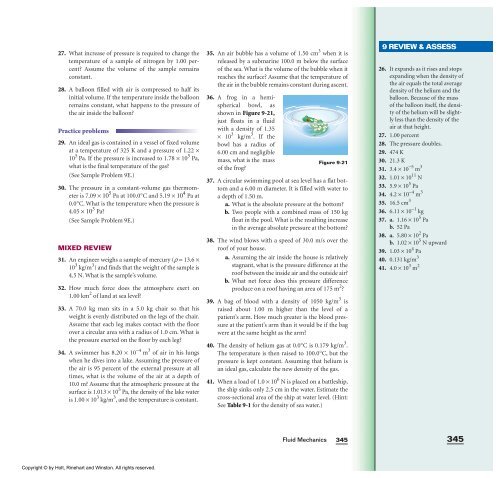You also want an ePaper? Increase the reach of your titles
YUMPU automatically turns print PDFs into web optimized ePapers that Google loves.
27. What increase of pressure is required to change the<br />
temperature of a sample of nitrogen by 1.00 percent?<br />
Assume the volume of the sample remains<br />
constant.<br />
28. A balloon filled <strong>with</strong> air is compressed to half its<br />
initial volume. If the temperature inside the balloon<br />
remains constant, what happens to the pressure of<br />
the air inside the balloon?<br />
Practice problems<br />
29. An ideal gas is contained in a vessel of fixed volume<br />
at a temperature of 325 K and a pressure of 1.22 ×<br />
10 5 Pa. If the pressure is increased to 1.78 × 10 5 Pa,<br />
what is the final temperature of the gas?<br />
(See Sample Problem 9E.)<br />
30. The pressure in a constant-volume gas thermometer<br />
is 7.09 × 10 5 Pa at 100.0°C and 5.19 × 10 4 Pa at<br />
0.0°C. What is the temperature when the pressure is<br />
4.05 × 10 3 Pa?<br />
(See Sample Problem 9E.)<br />
MIXED REVIEW<br />
31. An engineer weighs a sample of mercury (r = 13.6 ×<br />
10 3 kg/m 3 ) and finds that the weight of the sample is<br />
4.5 N. What is the sample’s volume.<br />
32. How much force does the atmosphere exert on<br />
1.00 km 2 of land at sea level?<br />
33. A 70.0 kg man sits in a 5.0 kg chair so that his<br />
weight is evenly distributed on the legs of the chair.<br />
Assume that each leg makes contact <strong>with</strong> the floor<br />
over a circular area <strong>with</strong> a radius of 1.0 cm. What is<br />
the pressure exerted on the floor by each leg?<br />
34. A swimmer has 8.20 × 10 −4 m 3 of air in his lungs<br />
when he dives into a lake. Assuming the pressure of<br />
the air is 95 percent of the external pressure at all<br />
times, what is the volume of the air at a depth of<br />
10.0 m? Assume that the atmospheric pressure at the<br />
surface is 1.013 × 10 5 Pa, the density of the lake water<br />
is 1.00 × 10 3 kg/m 3 , and the temperature is constant.<br />
Copyright © by Holt, Rinehart and Winston. All rights reserved.<br />
35. An air bubble has a volume of 1.50 cm 3 when it is<br />
released by a submarine 100.0 m below the surface<br />
of the sea. What is the volume of the bubble when it<br />
reaches the surface? Assume that the temperature of<br />
the air in the bubble remains constant during ascent.<br />
36. A frog in a hemispherical<br />
bowl, as<br />
shown in Figure 9-21,<br />
just floats in a fluid<br />
<strong>with</strong> a density of 1.35<br />
× 10 3 kg/m 3 . If the<br />
bowl has a radius of<br />
6.00 cm and negligible<br />
mass, what is the mass<br />
of the frog?<br />
37. A circular swimming pool at sea level has a flat bottom<br />
and a 6.00 m diameter. It is filled <strong>with</strong> water to<br />
a depth of 1.50 m.<br />
a. What is the absolute pressure at the bottom?<br />
b. Two people <strong>with</strong> a combined mass of 150 kg<br />
float in the pool. What is the resulting increase<br />
in the average absolute pressure at the bottom?<br />
38. The wind blows <strong>with</strong> a speed of 30.0 m/s over the<br />
roof of your house.<br />
a. Assuming the air inside the house is relatively<br />
stagnant, what is the pressure difference at the<br />
roof between the inside air and the outside air?<br />
b. What net force does this pressure difference<br />
produce on a roof having an area of 175 m 2 ?<br />
39. A bag of blood <strong>with</strong> a density of 1050 kg/m 3 is<br />
raised about 1.00 m higher than the level of a<br />
patient’s arm. How much greater is the blood pressure<br />
at the patient’s arm than it would be if the bag<br />
were at the same height as the arm?<br />
40. The density of helium gas at 0.0°C is 0.179 kg/m 3 .<br />
The temperature is then raised to 100.0°C, but the<br />
pressure is kept constant. Assuming that helium is<br />
an ideal gas, calculate the new density of the gas.<br />
41. When a load of 1.0 × 10 6 N is placed on a battleship,<br />
the ship sinks only 2.5 cm in the water. Estimate the<br />
cross-sectional area of the ship at water level. (Hint:<br />
See Table 9-1 for the density of sea water.)<br />
<strong>Fluid</strong> <strong>Mechanics</strong><br />
Figure 9-21<br />
345<br />
9 REVIEW & ASSESS<br />
26. It expands as it rises and stops<br />
expanding when the density of<br />
the air equals the total average<br />
density of the helium and the<br />
balloon. Because of the mass<br />
of the balloon itself, the density<br />
of the helium will be slightly<br />
less than the density of the<br />
air at that height.<br />
27. 1.00 percent<br />
28. The pressure doubles.<br />
29. 474 K<br />
30. 21.3 K<br />
31. 3.4 × 10 −5 m 3<br />
32. 1.01 × 10 11 N<br />
33. 5.9 × 10 5 Pa<br />
34. 4.2 × 10 −4 m 3<br />
35. 16.5 cm 3<br />
36. 6.11 × 10 −1 kg<br />
37. a. 1.16 × 10 5 Pa<br />
b. 52 Pa<br />
38. a. 5.80 × 10 2 Pa<br />
b. 1.02 × 10 5 N upward<br />
39. 1.03 × 10 4 Pa<br />
40. 0.131 kg/m 3<br />
41. 4.0 × 10 3 m 2<br />
345
















